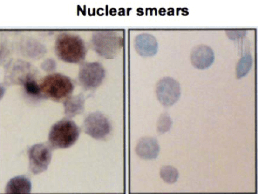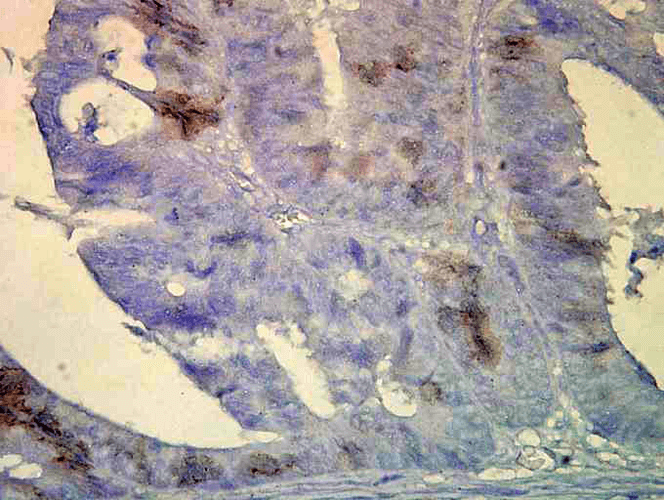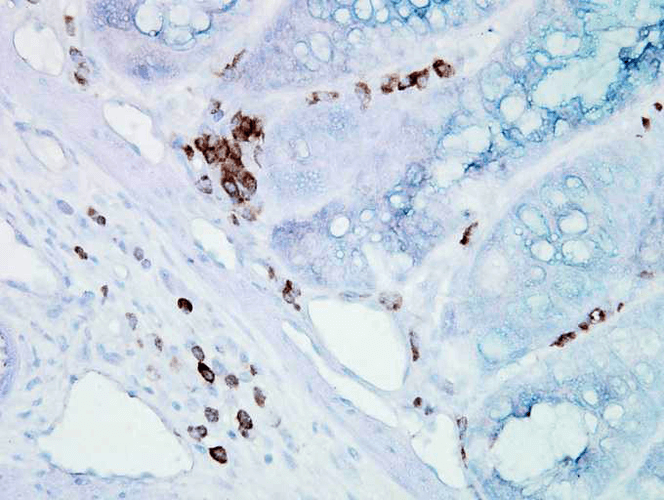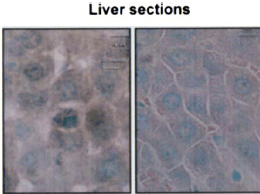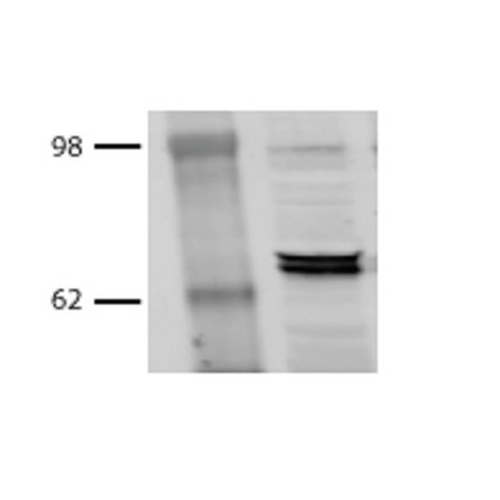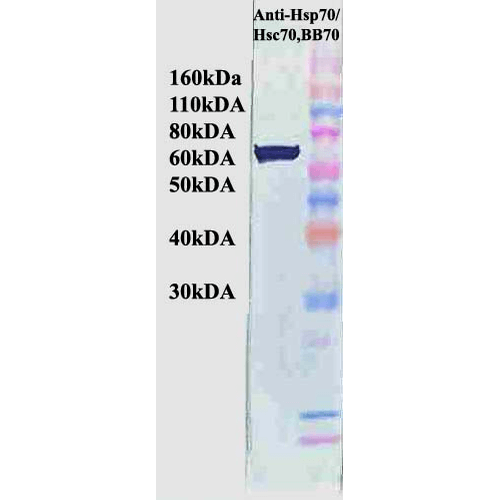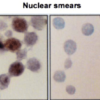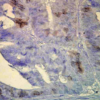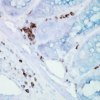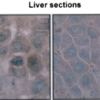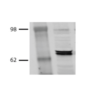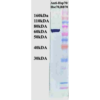Anti-Hsp70/Hsc70 Antibody (11099)
$338.00
| Host | Quantity | Applications | Species Reactivity | Data Sheet | |
|---|---|---|---|---|---|
| Mouse | 100ug | WB,ICC/IF,IHC,IP | Human, Mouse, Rat, Rabbit, Monkey, Hamster, Guinea Pig, Dog, Bovine, Sheep, Pig, Chicken, Yeast, Fish, Xenopus |  |
SKU: 11099
Categories: Antibody Products, Heat Shock and Stress Protein Antibodies, Products
Overview
Product Name Anti-Hsp70/Hsc70 Antibody (11099)
Description Anti-Hsp70/Hsc70 Mouse Monoclonal Antibody
Target Hsp70/Hsc70
Species Reactivity Human, Mouse, Rat, Rabbit, Monkey, Hamster, Guinea Pig, Dog, Bovine, Sheep, Pig, Chicken, Yeast, Fish, Xenopus
Applications WB,ICC/IF,IHC,IP
Host Mouse
Clonality Monoclonal
Clone ID BB70
Isotype IgG2a
Immunogen Chicken Hsp70/Hsp90 complex.
Properties
Form Liquid
Concentration Lot Specific
Formulation PBS, pH 7.4, 0.1% sodium azide.
Buffer Formulation Phosphate Buffered Saline
Buffer pH pH 7.4
Buffer Anti-Microbial 0.1% Sodium Azide
Format Purified
Purification Purified by Protein G affinity chromatography
Specificity Information
Specificity This antibody detects 72 and 73kDa proteins corresponding to the predicted molecular masses of Hsp70 and Hsc70, respectively, on immunoblots of human, mouse, rat, rabbit, monkey, hamster, guinea pig, dog, bovine, sheep, pig, chicken yeast, fish, and Xenopus samples. This antibody recognizes the inducible and constitutive forms of Hsp70 and does not cross-react with Hsp90.
Target Name Heat shock 70 kDa protein
Target ID Hsp70/Hsc70
Uniprot ID P08106
Alternative Names HSP70
Gene ID 423504
Accession Number NP_001006686.1
Biological Function Molecular chaperone implicated in a wide variety of cellular processes, including protection of the proteome from stress, folding and transport of newly synthesized polypeptides, activation of proteolysis of misfolded proteins and the formation and dissociation of protein complexes. Plays a pivotal role in the protein quality control system, ensuring the correct folding of proteins, the re-folding of misfolded proteins and controlling the targeting of proteins for subsequent degradation. This is achieved through cycles of ATP binding, ATP hydrolysis and ADP release, mediated by co-chaperones. The affinity for polypeptides is regulated by its nucleotide bound state. In the ATP-bound form, it has a low affinity for substrate proteins. However, upon hydrolysis of the ATP to ADP, it undergoes a conformational change that increases its affinity for substrate proteins. It goes through repeated cycles of ATP hydrolysis and nucleotide exchange, which permits cycles of substrate binding and release. {UniProtKB:P0DMV8}.
Research Areas Heat Shock& Stress Proteins
Background Members of the Hsp70 family are molecular chaperones that function in protein folding, transport, maturation and degradation by binding to nascent polypeptide chains as well as partially folded protein intermediates and preventing their aggregation and misfolding. The 70kDa heat shock cognate protein, Hsc70, is closely related biochemically and biologically to Hsp70.
Application Images







Description Immunocytochemistry/Immunofluorescence analysis using Mouse Anti-Hsp70 Monoclonal Antibody, Clone BB70 (11099). Tissue: hepatocyte nuclei. Species: Rat. Primary Antibody: Mouse Anti-Hsp70 Monoclonal Antibody (11099) at 1:200. Liver sections were paraffin embedded. First pictures in series show two hours after exposure to stress, the second shows the control. Courtesy of: G. Matic, University of Belgrade, Serbia.

Description Immunohistochemistry analysis using Mouse Anti-Hsp70 Monoclonal Antibody, Clone BB70 (11099). Tissue: colon carcinoma. Species: Human. Fixation: Formalin. Primary Antibody: Mouse Anti-Hsp70 Monoclonal Antibody (11099) at 1:10000 for 12 hours at 4°C. Secondary Antibody: Biotin Goat Anti-Mouse at 1:2000 for 1 hour at RT. Counterstain: Mayer Hematoxylin (purple/blue) nuclear stain at 200 µl for 2 minutes at RT. Localization: Inflammatory cells. Magnification: 40x. HSP70/HSC70 cells stained brown. This image was produced using an amplifying IHC wash buffer. The antibody has therefore been diluted more than is recommended for other applications.

Description Immunohistochemistry analysis using Mouse Anti-Hsp70 Monoclonal Antibody, Clone BB70 (11099). Tissue: inflamed colon. Species: Mouse. Fixation: Formalin. Primary Antibody: Mouse Anti-Hsp70 Monoclonal Antibody (11099) at 1:10000 for 12 hours at 4°C. Secondary Antibody: Biotin Goat Anti-Mouse at 1:2000 for 1 hour at RT. Counterstain: Mayer Hematoxylin (purple/blue) nuclear stain at 200 µl for 2 minutes at RT. Localization: Inflammatory cells. Magnification: 40x. Inflammatory cells. HSP70/HSC70 stained brown. This image was produced using an amplifying IHC wash buffer. The antibody has therefore been diluted more than is recommended for other applications.

Description Immunohistochemistry analysis using Mouse Anti-Hsp70 Monoclonal Antibody, Clone BB70 (11099). Tissue: hepatocytes. Species: Rat. Fixation: Paraffin Embedded. Primary Antibody: Mouse Anti-Hsp70 Monoclonal Antibody (11099) at 1:200. Liver sections were paraffin embedded. First pictures in series show two hours after exposure to stress, the second shows the control. Courtesy of: G. Matic, University of Belgrade, Serbia.

Description Western Blot analysis of Bovine MDBK cell lysates showing detection of Hsp70 protein using Mouse Anti-Hsp70 Monoclonal Antibody, Clone BB70 (11099). Primary Antibody: Mouse Anti-Hsp70 Monoclonal Antibody (11099) at 1:1000.

Description Western Blot analysis of Human Cervical cancer cell line (HeLa) lysate showing detection of Hsp70 protein using Mouse Anti-Hsp70 Monoclonal Antibody, Clone BB70 (11099). Primary Antibody: Mouse Anti-Hsp70 Monoclonal Antibody (11099) at 1:1000. Secondary Antibody: HRP Goat Anti-Rat.
Handling
Storage This antibody is stable for at least one (1) year at -20°C.
Dilution Instructions Dilute in PBS or medium that is identical to that used in the assay system.
Application Instructions Immunoblotting: use at 1ug/mL.
Immunohistochemistry: use at 1-5ug/mL.
These are recommended concentrations.
Endusers should determine optimal concentrations for their applications.
Immunohistochemistry: use at 1-5ug/mL.
These are recommended concentrations.
Endusers should determine optimal concentrations for their applications.
References & Data Sheet
References Barent RL et al. 1998 Mol Endocrinol 12: 342. Felts SJ et al. 2000 J Biol Chem 275: 3305. Arlander SJ et al. 2003 J Biol Chem 278: 52572.
Data Sheet  Download PDF Data Sheet
Download PDF Data Sheet
 Download PDF Data Sheet
Download PDF Data Sheet

